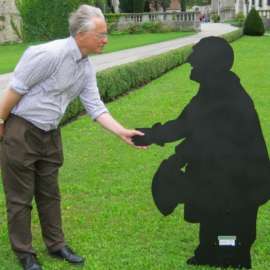In 1930 a seven-year-old boy was walking along a street in the misty city of Lwów (then Poland, now Ukraine) when he heard music coming from an open window: He was transfixed: “I was in a trance. I was in heaven – the world didn’t exist for me.” So shattered was he by the experience that he fell ill with a fever. The music that had this overwhelming effect on the boy was the Adagio from Bruckner’s Seventh Symphony. 82 years later it was our privilege to hear the grown man conduct that symphony with such a wealth of experience that it fitted him like a favourite old overcoat. The score remained closed in front of him: he knew every twist and turn, every entry, every dynamic change and every change in tempo, every necessary cue.
“To me, Bruckner is one of the greatest composers,” says Stanisław Skrowaczewski. “He is another Mozart: his music is magical... Its message speaks about the infinite, transcendental cosmos, God, timelessness, love and tragedy.” When in his 20s he became music director of the Silesian Philharmonic, Katowice (1949–54); he programmed Bruckner every season, and for over 60 years he has been performing Bruckner regularly worldwide, with a new recorded cycle currently in progress with the Yomiuri Nippon Symphony Orchestra in Tokyo. The quotations above and the extraordinary story of his life and career in Nazi and Soviet Poland can be found in Frederick Harris’ biography of the conductor, Seeking the Infinite.
This was one of those performances that leave you feeling nourished, rather than exhausted. You are to understand that there was nothing flashy or over-dramatised, no searching new interpretation, no revolutionary “new, improved” approach. This was Bruckner with over half a century of experience behind it, that had travelled through eastern Europe under the Nazis, under Stalin, through 20 years in Minneapolis and seven with The Hallé. The first movement began fairly slowly and in effect was a slow accelerando to the climax of the development where the LPO’s brass on top form blazed out the inversion of the main theme – then a sudden slowing and a wondrously sad calm in the recapitulation. It prepared for the grieving Adagio, with glorious playing from the quartet of Wagner tubas, a depth of expression in the main theme that is as valuable as it is rare: “love and tragedy”. And then a miracle: the second theme on violins played with such warmth and such heavenly lyricism, floating above the stepping quavers of the lower strings. An immense cymbal clash crowned the climax, followed by the dirge for Wagner tubas (embellished by all five horns towards its close) and the spare violin dialogue with the flute seeming to inhabit a mysterious other world. Skrowaczewski, often conducting towards the upper strings, turned right and gave a cue to a deathly low pizzicato from the cellos and double basses. The soul shuddered.
The world of here and now stormed back in the brassy Scherzo, where precise observation of the score gave us a trumpet call with accents only on its first three notes and hence a tendency to fade away, giving an air of subtlety to the movement that is rarely applied. The beautifully played trio evoked a nostalgic sadness. The finale’s characterisation, quick, pointed and light, was a perfect foil to all that had gone before, the Wagner tuba chorales excellently played, the brass’s rhythmic articulation of the dotted third theme really sharp and pointed.
Throughout the performance the LPO played magnificently, wonderfully enhanced by Skrowaczewski’s concern to get the balance right, to let all the inner voices speak. And they played Mozart equally well! In the first half the orchestral introduction to the Mozart Violin Concerto no. 5, deploying much smaller forces, was deftly articulated. Hilary Hahn’s violin playing was never less than rich and beautiful, and together orchestra and soloist presented a delightful first movement, with its Haydnesque tendency to surprise and confound all expectations. One such surprise is her Adagio entry, very affectingly played on this occasion, a strange little still interlude – as though a message from the Bruckner that was to come later. The Adagio proper was played with a deceptive lyrical simplicity, the cadenza with some very effective and expressively executed double-stopping. The Rondo finale contains the stomping so-called “Turkish” music that gives the concerto its nickname, and the orchestra thumped it out fabulously.
The concert displayed the 89-year-old conductor still at the height of his powers. Last week he was in Minneapolis supporting and conducting the “locked-out” Minnesota Orchestra, whose musicians have refused to agree to wage cuts, in Shostakovich’s Fifth. It is his rigorous devotion to music and courtesy to his fellow musicians that has characterised his career, and it continues to deliver music-making of rare quality, an honesty and integrity of which these days we are in desperate need, with the power to shake and rejuvenate the weary heart.


